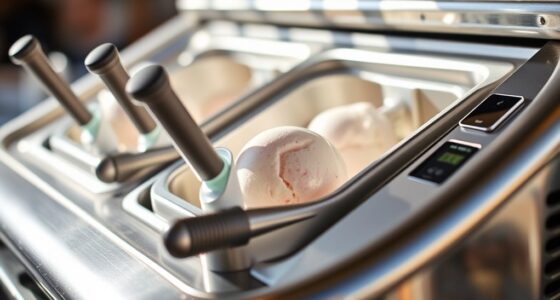Heat soak happens when your espresso machine’s internal parts hold onto residual heat, causing temperature fluctuations that affect shot quality. It often occurs due to prolonged use, poor insulation, or mineral buildup, leading to inconsistent brewing temperatures and flavor. To prevent it, you should allow adequate warm-up time, keep components preheated, and regularly maintain your machine. Staying aware of these factors can help you achieve more stable, flavorful espresso—learn more to master the process.
Key Takeaways
- Heat soak occurs when residual heat causes internal components to retain warmth, leading to temperature fluctuations during brewing.
- It results in inconsistent espresso shots, affecting flavor, extraction, and overall machine performance.
- Causes include prolonged use, poor insulation, mineral buildup, and heat transfer from the boiler to other parts.
- Preventive measures include proper warm-up routines, regular cleaning, descaling, and insulating machine components.
- Regular maintenance and temperature regulation help minimize heat soak, ensuring stable brewing temperatures and consistent espresso quality.
What Is Heat Soak and Why Does It Matter?
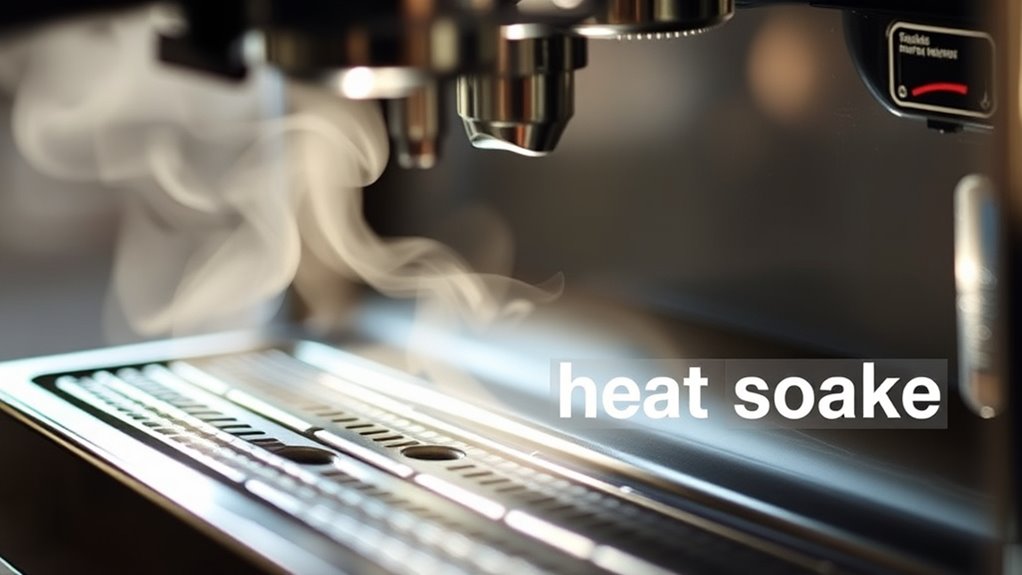
Heat soak occurs when an espresso machine’s internal components, especially the boiler and group head, retain residual heat after use. This heat retention causes thermal expansion, where metal parts expand slightly due to lingering warmth. If you don’t manage heat soak, it can lead to inconsistent espresso extraction because the machine’s temperature fluctuates unexpectedly. The retained heat can also cause the internal temperature to rise over time, affecting the stability of brewing temperatures. Understanding heat soak is essential because it impacts your espresso’s flavor and consistency. By recognizing how residual heat builds up through heat retention, you can implement strategies to minimize its effects, ensuring your machine maintains ideal temperature and delivers better, more consistent shots every time. Regular maintenance and proper temperature regulation are crucial for preventing heat soak from compromising your espresso quality.
The Science Behind Temperature Fluctuations
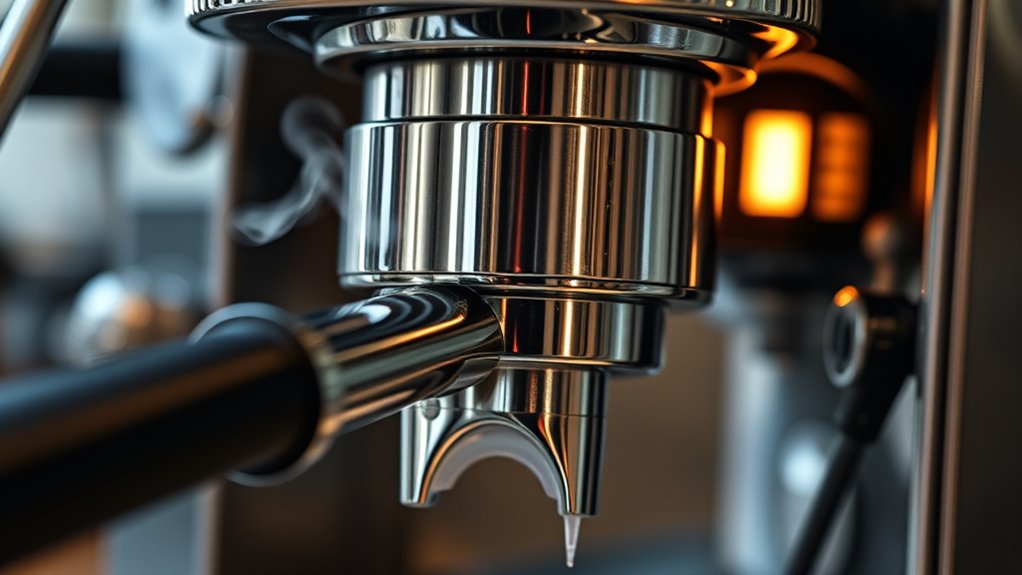
When residual heat builds up inside an espresso machine, it causes temperature fluctuations that can disrupt the brewing process. This happens because of thermal inertia, which is the machine’s resistance to temperature change. As heat transfer occurs between different parts, like the boiler, group head, and water, uneven temperatures develop. These fluctuations make it hard to maintain a stable brewing temperature, affecting extraction quality. The more thermal inertia a machine has, the longer it takes for temperature changes to settle, leading to potential heat soak issues. Understanding how heat transfer influences these fluctuations helps you identify why your espresso might taste inconsistent. Managing residual heat and controlling heat transfer are key to maintaining a stable temperature during extraction. Additionally, ethical hacking principles, such as identifying vulnerabilities, can be applied to analyze and improve espresso machine thermal management systems.
Common Causes of Heat Soak in Espresso Machines
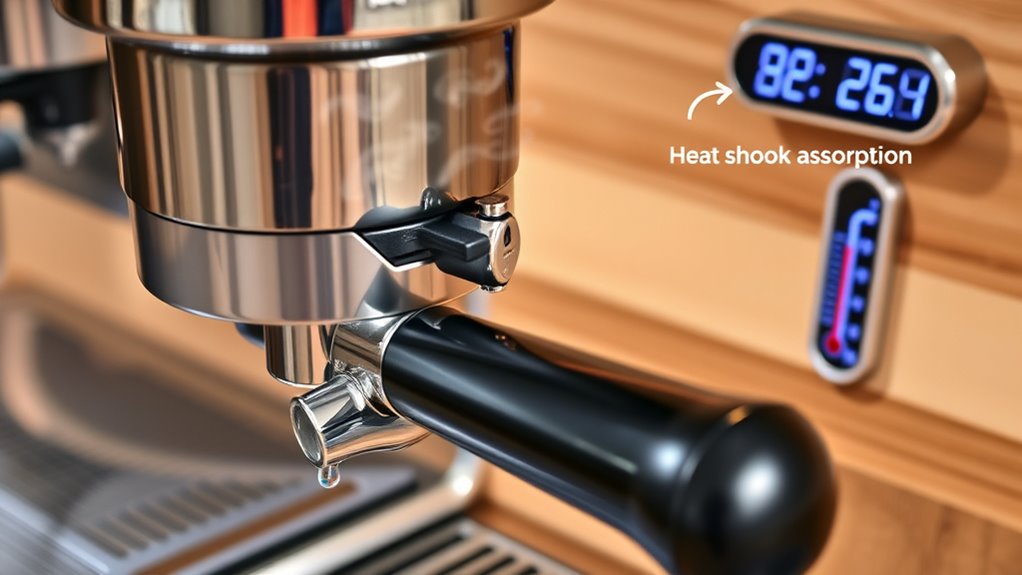
One common cause of heat soak in espresso machines is the buildup of residual heat from prolonged use. When your machine runs continuously, heat can transfer from the boiler to other components, causing uneven temperatures. Poor water quality can exacerbate this issue; mineral deposits build up inside the boiler and water pathways, reducing heat efficiency and promoting heat retention. Additionally, inadequate boiler insulation allows heat to escape or become unevenly distributed, making the machine more susceptible to heat soak. Over time, these factors combine, leading to temperature fluctuations that compromise espresso quality. Regular descaling, using high-quality water, and ensuring proper boiler insulation are essential steps to minimize heat buildup and prevent heat soak from affecting your espresso machine’s performance. Staying informed about legislative changes related to maintenance and water quality standards can further help in maintaining optimal machine operation.
Signs Your Machine Is Suffering From Heat Soak
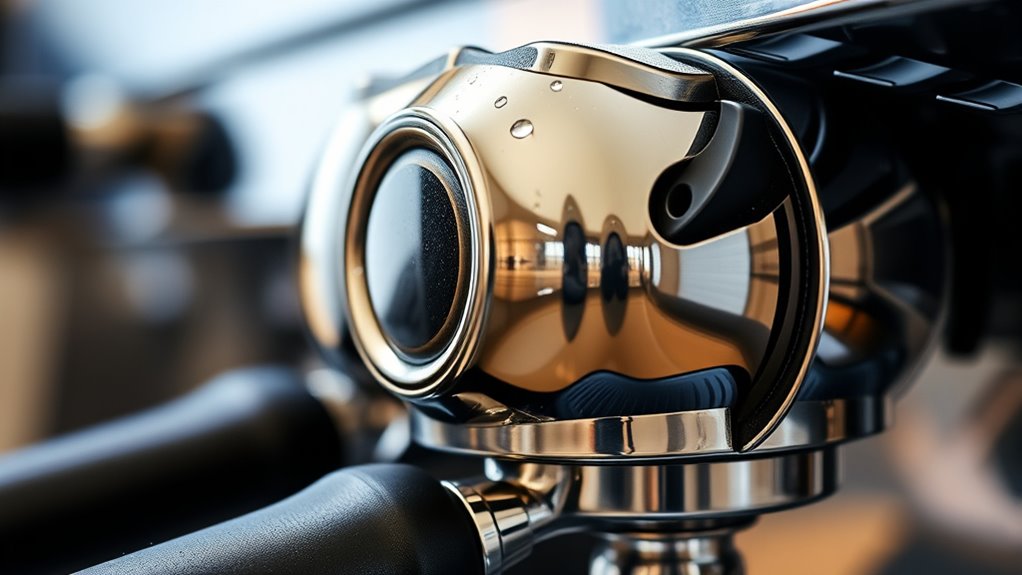
You might notice your espresso shots aren’t consistent in temperature, which can be a clear sign of heat soak. Unexpected fluctuations during brewing or prolonged changes in brew time also indicate your machine could be overheating. Recognizing these signs early helps you address the problem before it worsens. Additionally, inadequate cooling mechanisms can exacerbate heat soak issues, leading to more frequent temperature inconsistencies.
Signs of Inconsistent Espresso Temperature
Inconsistent espresso temperature often signals that your machine is suffering from heat soak, which can disrupt the brewing process. If you notice your shots vary in temperature from one to the next, it’s a clear sign your brew temperature isn’t stable. You might find that some shots taste sour or under-extracted, while others are bitter or over-extracted, indicating flavor inconsistency. This fluctuation can happen even if you’re using the same grind size and tamp pressure. When heat soak occurs, the machine’s internal temperature drops after initial use, leading to uneven heat transfer. As a result, your espresso’s flavor profile becomes unpredictable, making it difficult to achieve a consistently balanced shot. Recognizing these signs helps you identify heat soak early and take steps to prevent it.
Unexpected Temperature Fluctuations
Unexpected temperature fluctuations during espresso extraction often indicate heat soak in your machine. When heat soak occurs, your machine struggles to maintain consistent temperature stability, leading to unpredictable shifts during brewing. You might notice the shot starts at the right temperature but then suddenly cools or overheats mid-extraction. These fluctuations are signs that boiler efficiency has declined, causing inconsistent heat transfer. As the boiler’s ability to sustain stable temperatures diminishes, your espresso’s flavor and quality suffer. Recognizing these signs early helps you identify heat soak issues before they worsen. Ensuring your machine is properly maintained and insulated can improve boiler efficiency and promote more consistent temperature stability, reducing unexpected fluctuations during your espresso pulls. Additionally, implementing robust safety measures can help prevent damage caused by temperature irregularities and extend the lifespan of your espresso machine.
Prolonged Brew Time Variations
Prolonged brew times are a key indicator that your espresso machine may be suffering from heat soak. When your machine experiences heat soak, brew time consistency can become unpredictable, often resulting in longer extraction periods. This happens because the internal temperature drops or fluctuates, affecting temperature stability during brewing. If you notice that your shots are taking increasingly longer to pull or vary from shot to shot, heat soak could be the culprit. These variations can lead to inconsistent flavor extraction and compromised espresso quality. By monitoring your brew times and noticing irregularities, you can identify when your machine’s heat management is failing. Addressing heat soak helps restore temperature stability, ensuring your brew times remain consistent and your espresso stays flavorful. Additionally, understanding heat management techniques can prevent heat soak from occurring in the first place.
Practical Strategies to Minimize Heat Soak
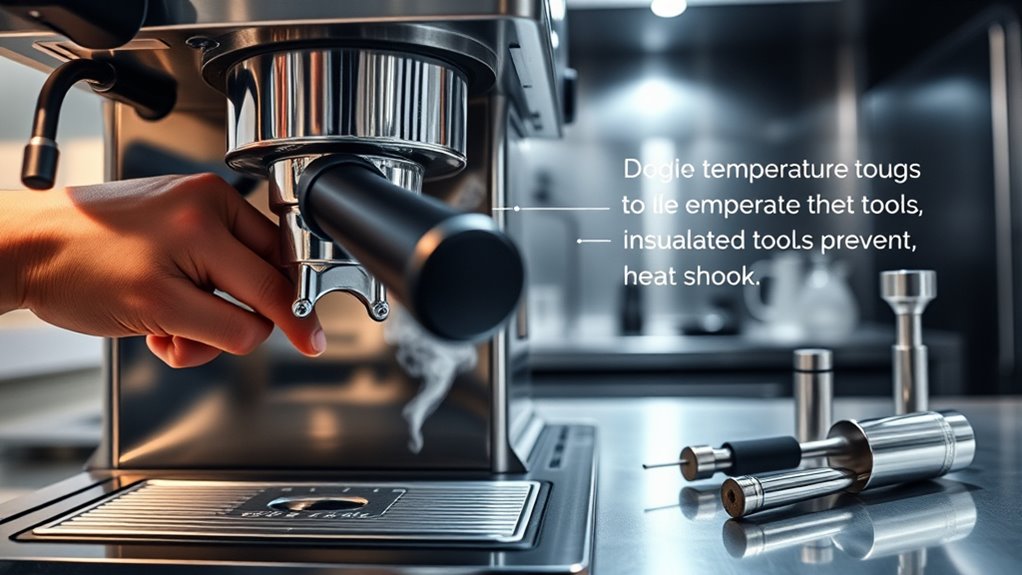
To effectively minimize heat soak in your espresso machine, you should start by giving the machine ample time to warm up before brewing. This guarantees stable water temperature and reduces fluctuations during extraction. Maintaining dosing consistency is also essential; use a scale to measure your coffee grounds precisely each time. Consistent doses help keep the puck density uniform, which influences heat retention and transfer. Additionally, preheat your portafilter and cups to prevent temperature drops during extraction. Regularly monitor your water temperature with a thermometer to guarantee it stays within the ideal range. By combining proper warm-up, precise dosing, and temperature regulation, you can markedly reduce heat soak and achieve more consistent, high-quality espresso shots.
Maintenance Tips to Keep Your Espresso Machine Consistent
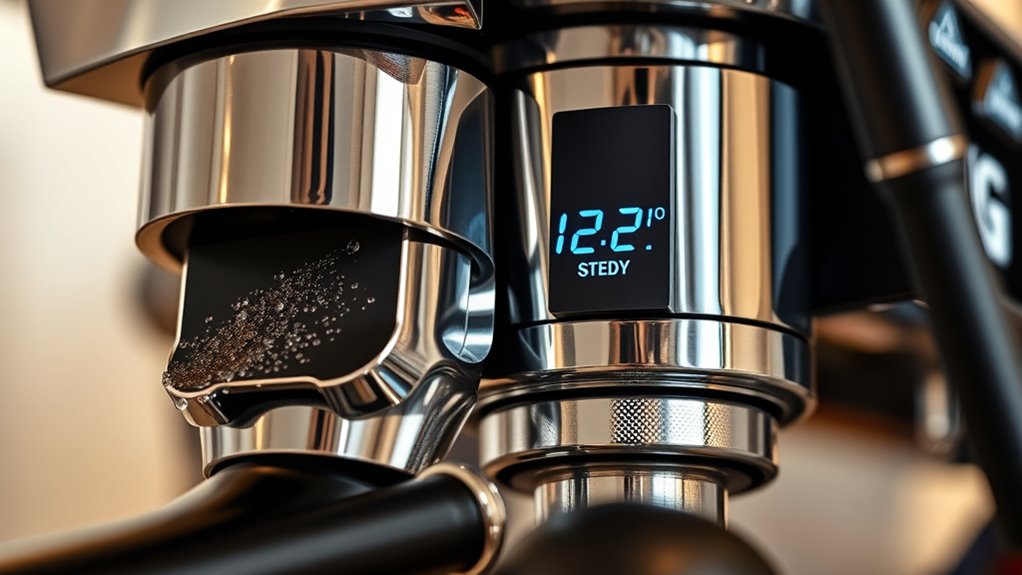
Regular maintenance is essential to keep your espresso machine producing consistent results. Start with regular cleaning routines to prevent buildup that can affect temperature stability and shot quality. Descale your machine periodically to remove mineral deposits that interfere with heat transfer. Keep your espresso grinder calibrated; inconsistent grind sizes can cause uneven extraction and flavor variations. Check for wear and replace worn parts like seals and gaskets to maintain proper pressure and temperature. Also, regularly purge the group head and steam wand to remove residual water and coffee oils. Maintaining proper machine calibration is crucial for consistent brewing performance. By sticking to these maintenance routines, you reduce the risk of heat soak and ensure your espresso stays hot, flavorful, and consistent shot after shot.
Frequently Asked Questions
Can Heat Soak Affect the Flavor of My Espresso?
Yes, heat soak can affect the flavor of your espresso. When your machine experiences temperature fluctuations due to heat soak, it can lead to inconsistent brewing temperatures. This inconsistency impacts flavor, making it less balanced and more variable from shot to shot. To maintain flavor consistency, it’s essential to minimize heat soak by allowing your machine to cool properly between uses and using techniques to stabilize temperature.
How Long Does Heat Soak Typically Last in an Espresso Machine?
Heat soak in your espresso machine usually lasts between 15 to 30 minutes, depending on its thermal stability and how often you perform temperature cycling. During this period, the machine’s components retain residual heat, affecting temperature consistency. To minimize this, avoid rapid temperature changes and give your machine time to stabilize after heavy use. Proper warm-up routines help maintain steady temperatures, ensuring better espresso quality and consistent flavor.
Does Water Hardness Influence Heat Soak Issues?
Water hardness, influenced by water mineralization, can affect heat soak issues. When your water has high calcium deposits, it promotes mineral buildup inside your machine. This buildup traps heat, making it harder for your machine to regulate temperature and leading to prolonged heat soak. To prevent this, use soft or filtered water, minimizing calcium deposits and ensuring your espresso machine maintains ideal temperature without heat soak problems.
Are There Specific Brands More Prone to Heat Soak?
Some brands with a reputation for innovative machine design tend to be less prone to heat soak, while others with less focus on thermal stability might experience it more often. You should research brand reputation and how their machines manage heat, especially models with advanced cooling systems. Ultimately, choosing a well-designed espresso machine from a reputable brand can help reduce heat soak issues and improve your brewing consistency.
Can Aftermarket Parts Help Prevent Heat Soak?
You might wonder if aftermarket parts can help prevent heat soak. Upgrades like heat shields can be effective remedies, blocking excess heat from penetrating sensitive components. Installing aftermarket upgrades, such as insulated group covers or heat shields, creates a barrier that reduces heat transfer. These solutions can markedly improve your machine’s thermal stability, helping you maintain consistent espresso quality and prevent heat soak from affecting your brewing process.
Conclusion
Understanding heat soak is like mastering the secret recipe for perfect espresso. By keeping your machine well-maintained and mindful of temperature fluctuations, you’re fundamentally tuning a finely crafted instrument. When you prevent heat soak, you guarantee each shot hits the sweet spot, rich and warm as a summer sunset. Think of it as nurturing your espresso machine’s inner fire—so it’s always ready to brew perfection, every single time.


